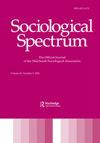社会经济地位、根本原因理论和处方阿片类药物使用行为:一个理论检验
IF 1.1
3区 社会学
Q2 SOCIOLOGY
引用次数: 3
摘要
本文应用Phelan等人的根本原因理论(FCT)框架,在具有全国代表性的美国成年人样本中研究社会经济地位(SES)与处方阿片类药物使用行为之间的关系。我还探讨了健康状况和灵活资源部署的中介作用。与FCT一致,结果表明,较高的SES与处方阿片类药物使用行为的几率显著降低相关。两种灵活的资源——医疗保健和社会支持——以及各种健康状况不佳的指标有助于解释这种关系。与FCT不一致的是,海洛因使用是“巨大风险”的知识并不是ses -处方阿片类药物使用行为关联的中介。基于这些发现,减少处方阿片类药物使用行为中的SES差异的努力应强调减少总体上的SES差异以及健康和获得重要健康促进资源的差异。讨论了本研究的局限性。本文章由计算机程序翻译,如有差异,请以英文原文为准。
Socioeconomic status, fundamental cause theory, and prescription opioid use behaviors: a theoretical examination
Abstract I applied Phelan et al.'s fundamental cause theory (FCT) framework to examine the association between socioeconomic status (SES) and prescription opioid use behaviors among a nationally representative sample of US adults. I also explored the mediating roles of health status and the deployment of flexible resources. Consistent with FCT, the results showed that higher SES was associated with significantly lower odds of prescription opioid use behaviors. Two flexible resources—health care access and social support—and various indicators of poor health helped explain this relationship. Inconsistent with FCT, knowledge of heroin use as being a “great risk” was not a mediator of the SES-prescription opioid use behaviors association. Based on these findings, efforts to reduce SES disparities in prescription opioid use behaviors should emphasize reducing SES disparities overall as well as in health and access to important health-enhancing resources. Limitations of this study are discussed.
求助全文
通过发布文献求助,成功后即可免费获取论文全文。
去求助
来源期刊

Sociological Spectrum
SOCIOLOGY-
CiteScore
3.80
自引率
5.60%
发文量
16
期刊介绍:
Sociological Spectrum publishes papers on theoretical, methodological, quantitative and qualitative research, and applied research in areas of sociology, social psychology, anthropology, and political science.
 求助内容:
求助内容: 应助结果提醒方式:
应助结果提醒方式:


